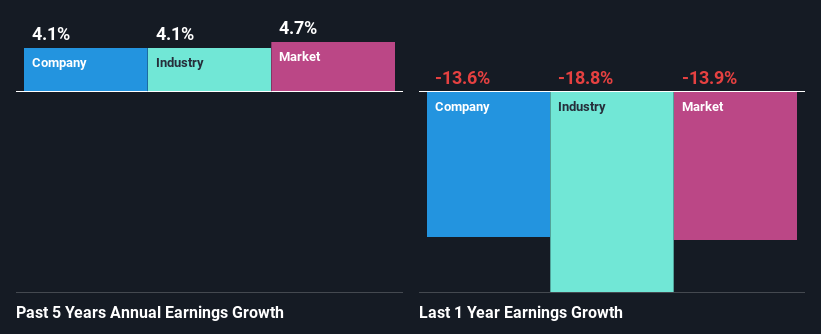Can Port of Tauranga Limited (NZSE:POT) Performance Keep Up Given Its Mixed Bag Of Fundamentals?
Most readers would already know that Port of Tauranga's (NZSE:POT) stock increased by 4.0% over the past week. Given that the stock prices usually follow long-term business performance, we wonder if the company's mixed financials could have any adverse effect on its current price price movement In this article, we decided to focus on Port of Tauranga's ROE.
Return on equity or ROE is an important factor to be considered by a shareholder because it tells them how effectively their capital is being reinvested. In other words, it is a profitability ratio which measures the rate of return on the capital provided by the company's shareholders.
Check out our latest analysis for Port of Tauranga
How To Calculate Return On Equity?
The formula for return on equity is:
Return on Equity = Net Profit (from continuing operations) ÷ Shareholders' Equity
So, based on the above formula, the ROE for Port of Tauranga is:
4.8% = NZ$102m ÷ NZ$2.1b (Based on the trailing twelve months to December 2023).
The 'return' is the amount earned after tax over the last twelve months. That means that for every NZ$1 worth of shareholders' equity, the company generated NZ$0.05 in profit.
Why Is ROE Important For Earnings Growth?
Thus far, we have learned that ROE measures how efficiently a company is generating its profits. We now need to evaluate how much profit the company reinvests or "retains" for future growth which then gives us an idea about the growth potential of the company. Assuming all else is equal, companies that have both a higher return on equity and higher profit retention are usually the ones that have a higher growth rate when compared to companies that don't have the same features.
Port of Tauranga's Earnings Growth And 4.8% ROE
At first glance, Port of Tauranga's ROE doesn't look very promising. However, its ROE is similar to the industry average of 4.8%, so we won't completely dismiss the company. Having said that, Port of Tauranga has shown a meagre net income growth of 4.1% over the past five years. Remember, the company's ROE is not particularly great to begin with. So this could also be one of the reasons behind the company's low growth in earnings.
We then performed a comparison between Port of Tauranga's net income growth with the industry, which revealed that the company's growth is similar to the average industry growth of 4.1% in the same 5-year period.
The basis for attaching value to a company is, to a great extent, tied to its earnings growth. What investors need to determine next is if the expected earnings growth, or the lack of it, is already built into the share price. Doing so will help them establish if the stock's future looks promising or ominous. One good indicator of expected earnings growth is the P/E ratio which determines the price the market is willing to pay for a stock based on its earnings prospects. So, you may want to check if Port of Tauranga is trading on a high P/E or a low P/E, relative to its industry.
Is Port of Tauranga Using Its Retained Earnings Effectively?
With a high three-year median payout ratio of 89% (or a retention ratio of 11%), most of Port of Tauranga's profits are being paid to shareholders. This definitely contributes to the low earnings growth seen by the company.
Moreover, Port of Tauranga has been paying dividends for at least ten years or more suggesting that management must have perceived that the shareholders prefer dividends over earnings growth. Upon studying the latest analysts' consensus data, we found that the company is expected to keep paying out approximately 91% of its profits over the next three years. However, Port of Tauranga's ROE is predicted to rise to 6.3% despite there being no anticipated change in its payout ratio.
Conclusion
In total, we're a bit ambivalent about Port of Tauranga's performance. While no doubt its earnings growth is pretty respectable, the low profit retention could mean that the company's earnings growth could have been higher, had it been paying reinvesting a higher portion of its profits. An improvement in its ROE could also help future earnings growth. That being so, the latest analyst forecasts show that the company will continue to see an expansion in its earnings. To know more about the latest analysts predictions for the company, check out this visualization of analyst forecasts for the company.
Have feedback on this article? Concerned about the content? Get in touch with us directly. Alternatively, email editorial-team (at) simplywallst.com.
This article by Simply Wall St is general in nature. We provide commentary based on historical data and analyst forecasts only using an unbiased methodology and our articles are not intended to be financial advice. It does not constitute a recommendation to buy or sell any stock, and does not take account of your objectives, or your financial situation. We aim to bring you long-term focused analysis driven by fundamental data. Note that our analysis may not factor in the latest price-sensitive company announcements or qualitative material. Simply Wall St has no position in any stocks mentioned.

 Yahoo Finance
Yahoo Finance 
